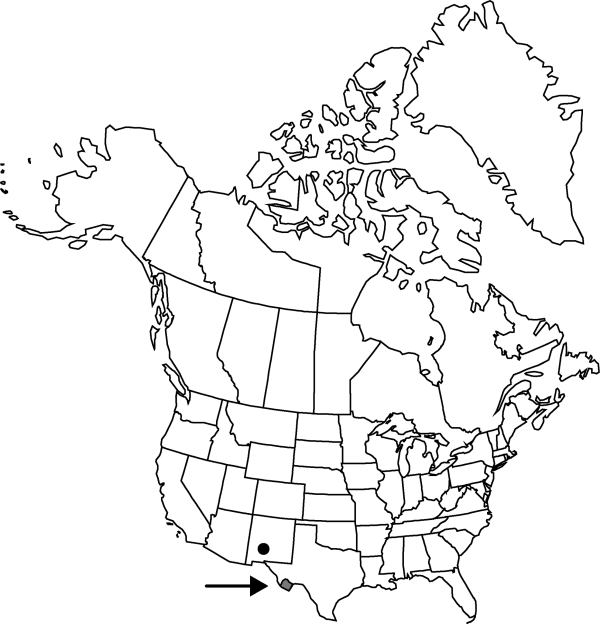Difference between revisions of "Coryphantha duncanii"
Cact. Succ. J. (Los Angeles) 41: 189. 1969.
FNA>Volume Importer |
imported>Volume Importer |
||
| (5 intermediate revisions by 2 users not shown) | |||
| Line 8: | Line 8: | ||
}} | }} | ||
|common_names=Duncan’s pincushion cactus | |common_names=Duncan’s pincushion cactus | ||
| − | |basionyms={{Treatment/ID/ | + | |special_status={{Treatment/ID/Special_status |
| + | |code=E | ||
| + | |label=Endemic | ||
| + | }}{{Treatment/ID/Special_status | ||
| + | |code=C | ||
| + | |label=Conservation concern | ||
| + | }} | ||
| + | |basionyms={{Treatment/ID/Basionym | ||
|name=Escobesseya duncanii | |name=Escobesseya duncanii | ||
|authority=Hester | |authority=Hester | ||
| + | |rank=species | ||
| + | |publication_title=Desert Pl. Life | ||
| + | |publication_place=13: 192. 1941 | ||
}} | }} | ||
|synonyms={{Treatment/ID/Synonym | |synonyms={{Treatment/ID/Synonym | ||
|name=Escobaria dasyacantha var. duncanii | |name=Escobaria dasyacantha var. duncanii | ||
|authority=(Hester) N. P. Taylor | |authority=(Hester) N. P. Taylor | ||
| + | |rank=variety | ||
}} {{Treatment/ID/Synonym | }} {{Treatment/ID/Synonym | ||
|name=Escobaria duncanii | |name=Escobaria duncanii | ||
|authority=(Hester) Backeberg | |authority=(Hester) Backeberg | ||
| + | |rank=species | ||
}} | }} | ||
|hierarchy=Cactaceae;Cactaceae subfam. Cactoideae;Coryphantha;Coryphantha duncanii | |hierarchy=Cactaceae;Cactaceae subfam. Cactoideae;Coryphantha;Coryphantha duncanii | ||
| Line 43: | Line 55: | ||
-->{{#Taxon: | -->{{#Taxon: | ||
name=Coryphantha duncanii | name=Coryphantha duncanii | ||
| − | |||
|authority=(Hester) L. D. Benson | |authority=(Hester) L. D. Benson | ||
|rank=species | |rank=species | ||
| Line 57: | Line 68: | ||
|publication title=Cact. Succ. J. (Los Angeles) | |publication title=Cact. Succ. J. (Los Angeles) | ||
|publication year=1969 | |publication year=1969 | ||
| − | |special status= | + | |special status=Endemic;Conservation concern |
| − | |source xml=https:// | + | |source xml=https://bitbucket.org/aafc-mbb/fna-data-curation/src/2e0870ddd59836b60bcf96646a41e87ea5a5943a/coarse_grained_fna_xml/V4/V4_423.xml |
|subfamily=Cactaceae subfam. Cactoideae | |subfamily=Cactaceae subfam. Cactoideae | ||
|genus=Coryphantha | |genus=Coryphantha | ||
Latest revision as of 21:58, 5 November 2020
Plants unbranched (rarely to 8 mature branches), white bristly spines obscuring stem. Roots dominated by a short or narrowly conic, carrotlike, succulent taproot, 1/3–1/2 of stem diam. Stems deep-seated, inconspicuous, obovoid, ovoid, or spheric to ± conic, 2.5–6 × 1–3.4 cm; tubercles 3–6 × 2.6–4 mm, moderately soft; areolar glands absent; parenchyma not mucilaginous; druses in pith and cortex abundant but nearly microscopic; pith 1/2 of lesser stem diam.; medullary vascular system absent. Spines (21–)31–44(–55) per areole, all snowy white, dark tips (tan to reddish brown) on medium and large spines; radial spines (18–)20–41 per areole, (4–)6–9(–10) × 0.03–0.2 mm; subcentral spines 0–12 per areole; outer central spines (1–)3–9(–17) per areole, appressed or (usually) slightly projecting; inner central spines (spines most likely to be interpreted as central) 0(–1) per areole, ascending, descending, or porrect, straight, longest spines (6–)7–14(–19) × 0.17–0.27 mm. Flowers nearly apical, 15–30 × 13–19 mm; outer tepals conspicuously fringed; inner tepals 14 per flower, margins white or cream (to light pink), midstripes pinkish to brown or brownish green, proximally white, 8–12 × 1.5–3 mm; outer filaments white or pinkish; anthers bright yellow; stigma lobes usually 4, dark green to bright yellow. Fruits bright red throughout, ellipsoid, cylindric, or clavate, 11–20 × 3–5 mm, not very succulent; floral remnant deciduous. Seeds black, ± spheric, ± 1.2 mm, pitted. 2n = 22.
Phenology: Flowering Feb–Mar(-May); fruiting mostly May.
Habitat: Limestone slopes, mostly in crevices of massive limestone outcrops
Elevation: 700-1700 m
Discussion
Of conservation concern.
Coryphantha duncanii is inconspicuous, difficult to identify, and usually rare. Other coryphanthas in its range have thicker spines, except for C. chaffeyi and C. dasyacantha. Coryphantha duncanii resembles a stunted, crevice-limited growth form of C. dasyacantha but has caducous floral remnant. It is closely related to C. zilziana Boedeker of Mexico.
Selected References
None.
